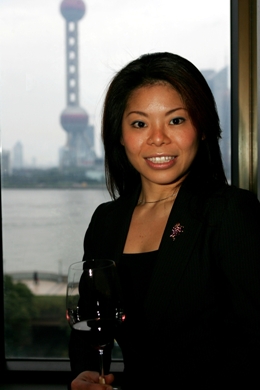By Yvonne Chiong
This is the second of two posts by Yvonne Chiong about her move to China to be a sommelier and her early experiences on the job.
Last time, I explained about how I came to Shanghai from my native Singapore to become a restaurant sommelier on the Bund. What were the first lessons I learned in my job?
Let’s start with my very first experience:
“Would you please put the red wine on ice? I would like it COLD,” said the customer. And it was a bottle of Carruades de Lafite.
What would I do?
I thought to myself, “It will not hurt my pride to fulfill my guest’s request without comment.”
The bottle went into a bucket half full of ice and with no water. After ten minutes, I poured. With the first sip, the guest commented that it was not as cold as he would like it.
With the most polite smile I could come up with, I explained the different ways and different temperatures with which to enjoy wine. My polite guest accepted the comments and told me that he liked them and would come back to drink and learn more!
Lesson 1: Be nice and smile, be professional, and take the perspective that the customer always comes first and is right. The customer will learn to trust you and then accept suggestions to try something different. Not that difficult? Perhaps I was just lucky…
Enter the next customer, and the next question: “Which is a red wine that is sweet?” Hmm. Chinese consumers actually like full-bodied wine, but they do not quite like wines which are high in tannins as they find them bitter.
I suggested a degustation – a sampling of several wines – to my customer and his [or her?] guests. They loved it. It was a great chance to taste wine – for free! They would, of course, pay for the full glass they eventually chose. We went from a Pinot Noir to a Merlot and finally to a Cabernet, one that was a little aged and from South Australia. Voilà ! The Cabernet was the one!
Lesson 2: Understand the customer’s palate and preferences. If it was to be “a sweet red wine” then it was to be a wine that is riper, full bodied, slightly aged and softer in tannins. Observe and understand how the customer describes his or her preference.
Enter another customer, this time from a wine-making country. “Hi! I come from [country name]. I hear that Chinese wines are not that great,” said the customer. “Is that really true?”
Well, here was another opportunity for me. I offered the customer a blind tasting game with two Grace Vineyard wines – Premium Chardonnay and Taysa’s Reserve Merlot. The tasting verdict: the customer guessed a French Chardonnay and a cold Cabernet! Seizing my opportunity, I explained a little about the history of Grace Vineyard.
Lesson 3: Open the eyes and taste buds of the customer by seizing on their interests and overcoming their bias. With a better selection of wines eventually coming from China , the wine-making world will be even more varied and rich.
Grape Wall has no sponsors of advertisers: if you find the content and projects like World Marselan Day worthwhile, please help cover the costs via PayPal, WeChat or Alipay.
Sign up for the free Grape Wall newsletter here. Follow Grape Wall on LinkedIn, Instagram, Facebook and Twitter. And contact Grape Wall via grapewallofchina (at) gmail.com.


Leave a Reply
You must be logged in to post a comment.